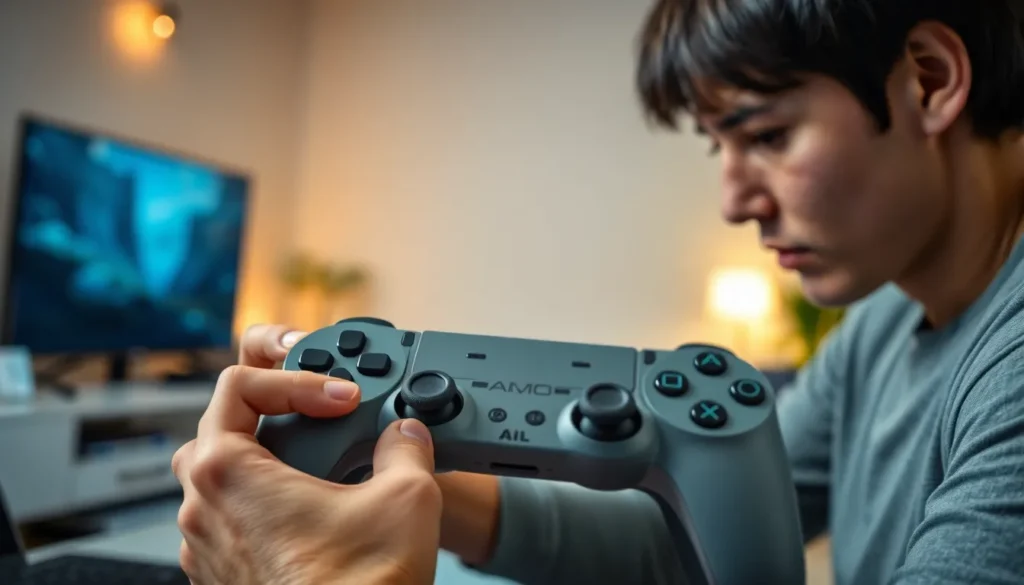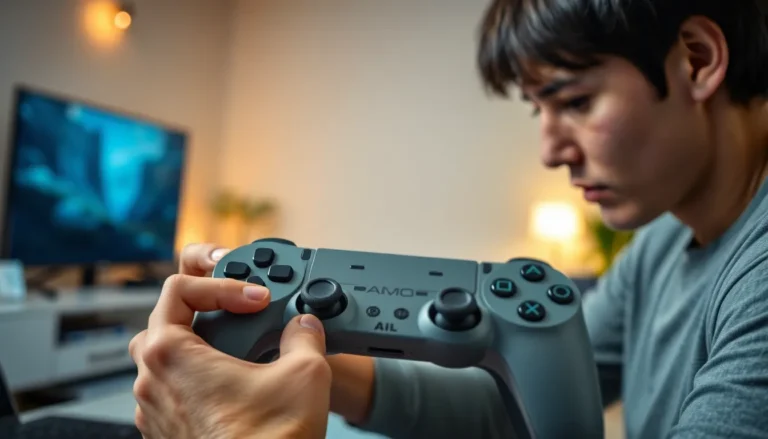In the fast-paced world of gaming, keeping your controller in tip-top shape is as crucial as mastering that final boss. Enter controller firmware updates—those magical little downloads that promise to enhance performance, fix pesky bugs, and sometimes even add new features. Think of them as the secret sauce that turns your trusty gamepad into a high-speed gaming machine.
Table of Contents
ToggleOverview Of Controller Firmware Updates
Controller firmware updates serve multiple purposes in enhancing user experience. These updates improve performance metrics across various gaming platforms. For example, a recent update may reduce input lag, leading to a more responsive gaming experience.
Security patches also feature prominently in firmware updates. They safeguard against vulnerabilities that could expose systems to potential threats. Regular updates greatly reduce risks associated with outdated software and enhance overall controller reliability.
New features may accompany some firmware updates. Enhancements like customizable button mapping provide players with tailored gaming experiences. Firmware updates can also optimize the battery life of wireless controllers, ensuring extended play sessions.
Users can often find firmware updates from official console or controller manufacturers. Downloading the necessary files typically involves connecting the controller to a PC or console. Following the manufacturer’s instructions ensures a smooth update process.
Staying current with firmware updates is crucial for maintaining optimal controller performance. Gamers can achieve better functionality by regularly checking for any available updates. Frequent updates not only fix existing bugs but also pave the way for new enhancements that elevate the gaming experience.
Importance Of Regular Updates

Regular updates are essential for maintaining peak performance and security of gaming controllers. These updates ensure controllers remain compatible with the latest games and enhancements.
Enhancing Performance
Upgrading firmware enhances overall performance significantly. Manufacturers often release updates that optimize response times and reduce input lag. Improved performance metrics directly influence gaming experiences, allowing for a smoother interface during gameplay. New features, like customizable button mapping, may also emerge with these updates, offering users greater control. Consistently applying updates ensures that the controller operates at its best, aligning seamlessly with evolving gaming standards.
Fixing Bugs And Vulnerabilities
Applying firmware updates addresses bugs and security vulnerabilities effectively. Bugs often impair gameplay and can frustrate users; however, timely updates resolve these issues. Security patches protect controllers from potential threats and exploits that could compromise user data. Taking advantage of the latest updates minimizes risks associated with outdated software, ensuring peace of mind while gaming. Regular maintenance of firmware also prevents a buildup of unresolved issues, enhancing longevity and reliability of the controller.
How To Perform Controller Firmware Updates
Performing controller firmware updates guarantees improved functionality and performance. Follow these steps for a successful update.
Step-By-Step Guide
- Check Compatibility: Ensure the controller is compatible with the gaming console.
- Download Firmware: Access the official manufacturer’s website to find the latest firmware files.
- Connect Controller: Use a USB cable to connect the controller to the console or computer.
- Launch Update Tool: Open the firmware update tool provided by the manufacturer.
- Initiate Update: Follow on-screen prompts to start the update process.
- Confirm Success: Wait for the update to complete, which may take several minutes.
- Disconnect Controller: Once updated, safely disconnect the controller and restart if necessary.
Tools And Software Required
A few essential tools and software streamline the update process. Users need a stable internet connection for downloading updates.
Firmware update tools, often available on manufacturer websites, guide users through updates.
USB cables, compatible with the specific controller, ensure a reliable connection during the process.
Additionally, a compatible computer or console fulfills the requirement for executing updates effectively.
Always ensure the latest version of the manufacturer’s software is installed for optimal results.
Common Issues During Updates
Controller firmware updates can sometimes present challenges. Understanding these common issues can help streamline the update process and prevent frustration.
Troubleshooting Tips
First, check the USB connection if the update fails. Loose cables can disrupt the process, leading to errors. Next, inspect the controller for compatibility with the new firmware version. An incompatible version can cause malfunctions.
Ensure the computer or console is running the latest software. Outdated software might not support firmware updates. Restarting the device before starting the update can refresh its system and resolve unexpected issues.
Monitor the update progress on-screen. It may take longer than expected; don’t interrupt the process unless prompted. If the update stalls, disconnect the controller and reconnect it, then retry.
Lastly, consult the manufacturer’s support page for specific errors. Official resources provide guidance tailored to unique troubleshooting scenarios, ensuring users address issues effectively.
Future Trends In Controller Firmware Updates
Emerging trends in controller firmware updates emphasize the integration of artificial intelligence. AI technology can personalize settings based on player behavior, enhancing the gaming experience. Developers are exploring machine learning algorithms to predict and adapt to user preferences in real time.
Increased over-the-air updates are becoming more common. Users benefit from automatic firmware updates that require minimal interaction. This convenience ensures controllers maintain peak performance without manual checks.
Enhanced security features are crucial as gaming moves further online. Firmware updates will include advanced encryption and protection against cybersecurity threats, ensuring user data remains secure. Regular updates will also address newly identified vulnerabilities efficiently.
Compatibility with additional devices presents another significant trend. Upcoming firmware updates may support an expanding range of gaming peripherals, enhancing versatility. This compatibility ensures seamless connections between various devices, improving the overall gaming ecosystem.
Virtual reality and augmented reality are influencing future updates as well. Controllers optimized for immersive experiences will receive tailored firmware adjustments, resulting in more responsive and intuitive gameplay. These advancements can provide players with a more engaging experience.
Lastly, user feedback integration into the firmware update process is gaining traction. By collecting and analyzing player input, developers can prioritize important features and improvements. This approach creates a more user-centered product development cycle.
Overall, future trends in controller firmware updates focus on personalization, security, compatibility, immersive experiences, and user engagement. Keeping up with these advancements remains essential for any serious gamer.
Staying up to date with controller firmware updates is essential for any gamer looking to enhance their experience. These updates not only improve performance and fix bugs but also introduce new features that can significantly elevate gameplay. By regularly checking for updates and following the proper installation procedures, users can ensure their controllers remain reliable and efficient.
As gaming technology continues to evolve, embracing these updates will keep players ahead of the curve. With advancements like AI integration and automatic updates on the horizon, the future of controller firmware looks promising. Prioritizing firmware maintenance is a smart move that can lead to a more enjoyable and immersive gaming experience.










